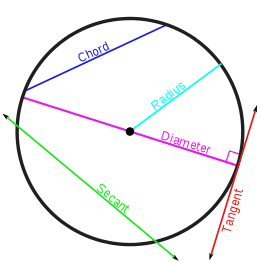Secant line

In geometry, a secant line of a curve is a line that (locally) intersects two points on the curve.[1] A chord is an interval of a secant line, the portion of the line that lies within the curve.[2] The word secant comes from the Latin word secare, meaning to cut.[3]
Secants can be used to approximate the tangent to a curve, at some point P. If the secant to a curve is defined by two points, P and Q, with P fixed and Q variable, as Q approaches P along the curve, the direction of the secant approaches that of the tangent at P, (assuming that the first derivative of the curve is continuous at point P so that there is only one tangent).[1] As a consequence, one could say that the limit, as Q approaches P, of the secant's slope, or direction, is that of the tangent. In calculus, this idea is the basis of the geometric definition of the derivative.
See also
- Elliptic curve, a curve for which every secant has a third point of intersection, from which a group law may be defined
- Quadrisecant, a line that intersects four points of a curve
- Secant plane, the three-dimensional equivalent of a secant line
References
- 1 2 Protter, Murray H.; Protter, Philip E. (1988), Calculus with Analytic Geometry, Jones & Bartlett Learning, p. 62, ISBN 9780867200935.
- ↑ Gullberg, Jan (1997), Mathematics: From the Birth of Numbers, W. W. Norton & Company, p. 387, ISBN 9780393040029.
- ↑ Redgrove, Herbert Stanley (1913), Experimental Mensuration: An Elementary Test-book of Inductive Geometry, Van Nostrand, p. 167.